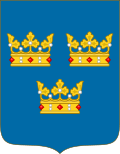Realm of Sweden
The term Svenska väldet ("Swedish dominion", as opposed to the name of Sweden Sverige, lit. "realm of the Swedes") is a term that historically was used to comprise all the territories under the control of the Swedish monarchs.
Part of a series on the |
|---|
| History of Sweden |
 |
|
Prehistoric
|
|
Consolidation
|
|
Great Power
|
|
Enlightenment
|
|
Liberalization
|
|
Modern
|
| Timeline |
|
|
Lands of Sweden
Researchers from the 19th century have suggested that in the 9th century Svealand, which they claimed was the historical core region of Sweden, expanded southwards, conquering Gothia. Little is known however from this time and more contemporary researchers have suggested that Gothia might as well have been the core region, or the two region were joined through a union.
In the latter part of 13th century Sweden expanded to the east conquering the parts which came to be called Österland, present-day Finland, through second and third crusades against Tavastians and Karelians. Norrland was made a part of the kingdom in the 16th century. In the 17th century the kingdom expanded to the south and east, except for short-period holdings in Norway, incorporating Scania, Blekinge, Halland and Bohuslän as well as Pomerania. On the other side of the Baltic Sea Kexholm County, Ingria and present day Latvia was also incorporated.
Provinces of Sweden
The four Swedish lands were in turn divided into separate Provinces or Landskap, which were governed by their own laws under the rule of a Ting. The monarchs would gradually strengthen their authority at the expense of the provinces, and in the 15th century the provincial laws were replaced by a single law for the entire kingdom.
Counties of Sweden
The Counties were established in 1634 to supersede the Provinces and to introduce a modern administration. The most significant change to the County system took place when Sweden was forced to cede the Finnish Counties to Russia in 1809. Despite this the County reform survived in Finland until 1997 and is still in force in Sweden today.
Dominions of Sweden
The Counties and Provinces represent territories that were fully integrated into the Swedish kingdom. Apart from this there also existed Dominions that were under Swedish rule, sometimes for centuries, that for various reasons weren't fully integrated.
Possessions of Sweden
The Swedish Crown also exercised control over various territories during shorter periods of time. These included time-limited fiefs, colonies and conquered territories under Swedish government.
Unions of Sweden
Sweden has for political and dynastic reasons been in union with other kingdoms and princely states, ostensibly personal unions.
Today
Today, "Realm of Sweden" can be used as a translation of the term Sveriges rike, which simply is a more solemn term for the contemporary Swedish state, and does not have the expansionist connotations which Svenska väldet may have. It is also worth noting that although Sweden remains a monarchy, modern Swedish constitutional law does not define the realm as belonging to the King personally, the government as being His Majesty's Government or the citizens of the realm as being His Majesty's subjects. Thus, "realm" has lost some of the connotations of "kingdom" that it might previously have had.
Structure of the Swedish Realm
| Century | Swedish Realm | ||||||
| 20th | Sweden proper | Finland | Estonia | Latvia | Germany | ||
| 19th | GD of Finland | Russia | Prussia | ||||
| 18th | Sweden proper | Pomerania¹ | |||||
| 17th | Terra Scania | Bahusia | Sweden proper | Estonia | Livonia | ||
| 16th | Denmark-Norway | Poland | Pomerania | ||||
| 15th | Kalmar Union | Sword Brethren | |||||
| 14th | Denmark Blechingia Hallandia Scania |
Norway Bahusia Herdalia Jemtia |
Sweden proper | ||||
| 13th | |||||||
| 12th | |||||||
| Peoples | Danes | Norwegians | Swedes | Finns | Estonians | Livonians | Germans |
1/ German dominions also include Bremen-Verden, Wismar, etc. Claims to Wismar finally renounced in 1903.